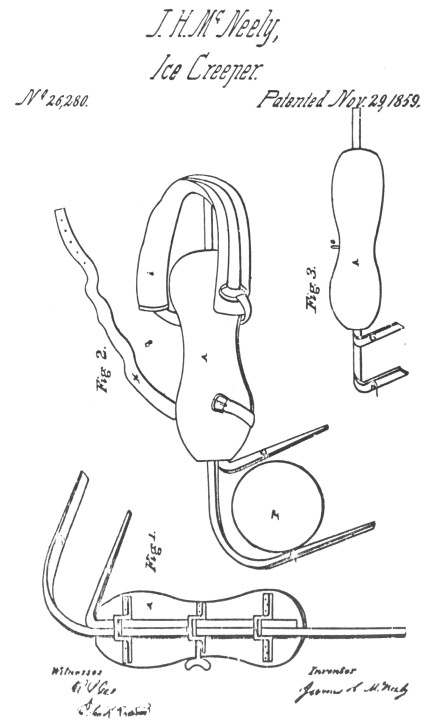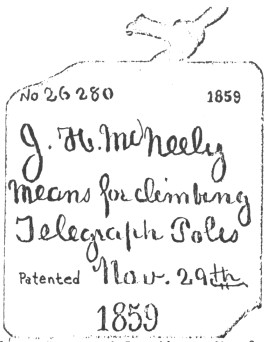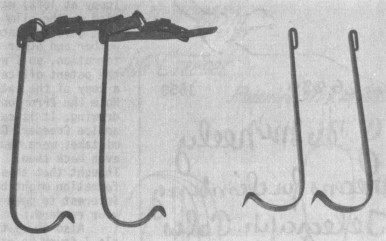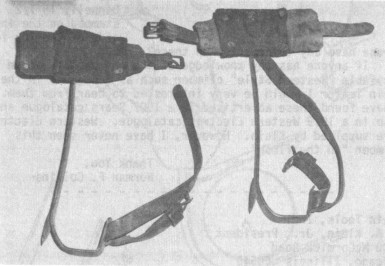More about Early Pole Climbers
Reprinted from "INSULATORS - Crown Jewels of the Wire", August 1976, page 3
Dear Don and Dora,
I am writing in reference to the article on climbers that appeared in your
May 1976 issue of the Crown Jewels.
Enclosed you will find a copy of a Patent No. 26,280 issued to a James H.
McNeeley of Indianapolis, Ind. on Nov. 29, 1859. As you will note, it describes
in detail a climber or "Means for climbing telegraph poles".
I found a single prototype of this climber in an antique shop in Greenfield,
Massachusetts, some two years ago.
UNITED STATES PATENT OFFICE.
JAMES H. MCNEELY, OF INDIANAPOLIS, INDIANA.
MEANS FOR CLIMBING TELEGRAPH-POLES.
Specification of Letters Patent No. 26,280, dated November 29, 1859.
To all whom it may concern:
Be it known that I, James II. McNeely, of the city of Indianapolis, Marion
county, and State of Indiana, have invented a new and useful Implement for
Ascending and Descending Telegraph-Poles or other Upright Objects; and I do
hereby declare that the following is a full, clear, and exact description
thereof, reference being had to the accompanying drawings, and to the letters of
reference marked thereon, in which--
Figure 1 is an inverted view of the climber. Fig. 2 is a view of the climber
as used when ascending or descending upright objects, represented as having hold
of the pole P. which letter represents a transverse section of the object to be
ascended, and Fig. 3 is a side section of the climber, designed to show the
peculiar twist or angle in the bend of the hooks, by which allowance is made for
the taper in an object ascended or descended.
The nature of my invention consists in preparing a piece of iron A shaped as
shown in Fig. l, to the bottom of which are attached the loops (D), (E), and F
(Fig. 1) in which works the adjustable hook B. which is secured by the thumb
screw (G). The hook (C) is riveted to loops D, E, and F, and the whole implement
is attached to the foot of the user, by the toe and heel straps II and I, in the
manner of an ordinary skate. The curved arms of the hooks (B) and (C) are
twisted parallel to each other in such a way, that as the climber ascends, and
the pole becomes smaller, the heel of the implement lowers, and the gage of the
hooks becomes narrower, and while the climber is descending, the heel is
elevated and the gage becomes wider. This peculiar arrangement is shown by the
twist or angle of the hooks B and C in Fig. 3.
The climbers are made to be used in pairs, one for each foot, of the person
using them; and the hooks B and C are bent so as to point in toward the pole,
from each foot on which they are worn respectively.
The mode of using this implement is, after one of them is firmly strapped or
otherwise secured to each foot, then, by throwing the feet out and in
alternately, against the object which the climber is ascending, the hooks B
and C spanning the pole as is represented in Fig. 2 and being twisted as represented in Fig. 3 the lower edge of the hook (C) and the upper edge of the hook
(B) come in contact with the pole, and enables the person to ascend and work
with great facility. As the climber ascends, if the pole is tapering, the heel
of the implement becomes depressed, when, in consequence of the twist in the
bend of the hooks B and C as represented in Fig. 3 the gage becomes narrower, to
correspond with the decreased diameter of the pole. A still further change of
gage may be made by loosening the set screw (G) and sliding the hook (B) in
the proper distance. In descending, the climber reverses the operation
described, and thus provides for the increases diameter of the pole, or other
objects to be ascended and descended.
By the use of this invention, telegraph poles or other upright objects can be
ascended with about as much ease, as the climbing of a ladder, as the wearer
is enabled to obtain a fair foot hold, giving him an opportunity of strapping
himself to the post, mast, tree, pole or whatever he ascends, by which means he
is enabled to work with great ease, advantage and safety.
What I claim as my invention, and desire to secure by Letters Patent is--
The combination and arrangement of the hooks B and C with the loops D, E, and
F and set screw G, when constructed and operated substantially as set forth.
JAMES H. McNEELY,
Witnesses:
R. S. GEE,
JOHN H. REDSTONE
|
|

|

A tag (copy at left) was tied on the climber that gave the patent number and other
information, so I wrote for the patent office for a copy of the patent. Note the
error on the drawing. It is called an Ice Creeper. Guess mistakes were made even
back then. Thought that this information might be of interest to some of your
readers.
Also in my travels I found an early hand wrought set of Eastern style
climbers that have J. Donnelly 15 1/2 stamped on the inside of the leg iron.
Anyone have any information on these?
If anyone has any knowledge of the whereabouts of an available "Western
Style" climber such as described in the Klein letter I would be very
interested to hear from them. I have found these advertised in a 1907 Sears
catalogue and also in a 1919 Western Electric catalogue. Western Electric's were
supplied by Klein. However, I have never seen this climber "in the
flesh".
Thank you,
Norman F. Collins
Klein Tools, Inc.
M. A. Klein, Jr., President
7200 McCormick Road
Chicago,
Illinois 60645
Dear Mr. Klein:
Your February 2, 1976 letter to Mr. W. J. Dreggors, Jr. of the Florida Power
Corporation, which was printed in the May 1976 issue of "Insulators,"
was of great value to me.
You may be interested to know that we have two sets of the original type
climbers (one with the original leather straps), both stamped Klein & Sons.
We also have a set of early fixed gaff climbers (#17 Klein & Sons). Photos
of each type are enclosed.

Original Type Climbers

Early Fixed Gaff Climbers
I wish to thank you for your time spent in preparing the letter to Mr.
Dreggors, as it will now allow me to tell a better story about the climbers we
have. I knew they were old, but I didn't know much else about them.
Very truly yours,
WISCONSIN MICHIGAN POWER CO.
O. R. Boll
Manager of Engineering
|
